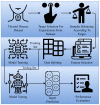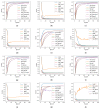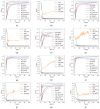Thyroid Disease Prediction Using Selective Features and Machine Learning Techniques
- PMID: 36010907
- PMCID: PMC9405591
- DOI: 10.3390/cancers14163914
Thyroid Disease Prediction Using Selective Features and Machine Learning Techniques
Abstract
Thyroid disease prediction has emerged as an important task recently. Despite existing approaches for its diagnosis, often the target is binary classification, the used datasets are small-sized and results are not validated either. Predominantly, existing approaches focus on model optimization and the feature engineering part is less investigated. To overcome these limitations, this study presents an approach that investigates feature engineering for machine learning and deep learning models. Forward feature selection, backward feature elimination, bidirectional feature elimination, and machine learning-based feature selection using extra tree classifiers are adopted. The proposed approach can predict Hashimoto's thyroiditis (primary hypothyroid), binding protein (increased binding protein), autoimmune thyroiditis (compensated hypothyroid), and non-thyroidal syndrome (NTIS) (concurrent non-thyroidal illness). Extensive experiments show that the extra tree classifier-based selected feature yields the best results with 0.99 accuracy and an F1 score when used with the random forest classifier. Results suggest that the machine learning models are a better choice for thyroid disease detection regarding the provided accuracy and the computational complexity. K-fold cross-validation and performance comparison with existing studies corroborate the superior performance of the proposed approach.
Keywords: bidirectional feature elimination; forward feature selection; machine learning; thyroid prediction.
Conflict of interest statement
The authors declare no conflict of interests.
Figures








References
-
- Chaubey G., Bisen D., Arjaria S., Yadav V. Thyroid disease prediction using machine learning approaches. Natl. Acad. Sci. Lett. 2021;44:233–238. doi: 10.1007/s40009-020-00979-z. - DOI
-
- Ioniţă I., Ioniţă L. Prediction of thyroid disease using data mining techniques. BRAIN Broad Res. Artif. Intell. Neurosci. 2016;7:115–124.
-
- Webster A., Wyatt S. Health, Technology and Society. Springer; Berlin/Heidelberg, Germany: 2020.
-
- Hong L., Luo M., Wang R., Lu P., Lu W., Lu L. Big data in health care: Applications and challenges. Data Inf. Manag. 2018;2:175–197. doi: 10.2478/dim-2018-0014. - DOI
-
- Association A.T. General Information/Press Room|American Thyroid Association. [(accessed on 7 April 2022)]. Available online: https://www.thyroid.org/media-main/press-room/
Grants and funding
LinkOut - more resources
Full Text Sources
Medical

